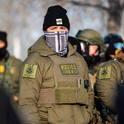If you want to understand the drama now unfolding in Oregon, checking out a photograph of Duane Ehmer riding his horse Hellboy across the high desert is not a bad place to start. Striving for the iconic, the Stars and Stripes in his hand, the Stars and Stripes on his jacket, the Stars and Stripes on his saddle blanket, he makes a pathetic, bathetic, cockeyed, grand—take your pick—spectacle, a performance for others, living out a dream for himself: Clint, Custer, the cavalryman at the crest of the hill, a Remington made flesh.
The stand-off at the Malheur National Wildlife Refuge began when a group of people, some armed, occupied the refuge’s headquarters (no staff were present at the time) as a protest, they said, against the federal government’s harsh treatment of two local ranchers, 73-year old Dwight Hammond and his son Steven.
The Hammonds were in a fix. Two fires they had set on their ranch—the first in 2001 supposedly routine maintenance (although the prosecution argued it was designed to cover up poaching on government property), the second in 2006, a defensive ‘backfire’—had spread onto neighbouring federal land. The damage was minimal, but the Hammonds hadn’t notified the Bureau of Land Management—the US government body responsible for administering more than 250 million acres of public land—before lighting either. That was unwise, and, in the case of the 2006 fire, quite possibly dangerous.
Father and son were sued in a civil case (they ended up paying the government $400,000). They were also prosecuted, convicted and imprisoned, but for very small fractions of the minimum five years mandated by the law. The trial judge ruled that a five-year term would be “grossly disproportionate”; it would constitute “cruel and unusual punishment” and, as such, be unconstitutional. The government appealed the sentence, outraged, perhaps, that these miscreants had got off too lightly. Then again, the Hammonds and the BLM, a sometimes overbearing body often resented by ranchers, had been feuding over grazing rights—and much more beside—for years. Uncle Sam may have simply taken the opportunity to deal with the Hammonds once for all.
But “grossly disproportionate” is routine when it comes to the application of America’s notorious minimum sentencing guidelines. After the appellate court considered the precedents that make the cruel all too usual, the Hammonds were resentenced to five years apiece, with credit for time served (both had already completed their original sentences). The two returned to prison this month.
The Hammonds’ plight attracted the attention of Ammon Bundy, one of the fourteen children of Cliven Bundy, the anti-government militant who had been at the center of the armed stand-off at his Nevada ranch in 2014 that (eventually) arose out of his longstanding refusal to recognize the authority of the BLM (and pay his grazing fees). The nut hadn’t fallen far from the tree: the younger Bundy arrived in Oregon to help, he claimed, the Hammonds out. The talk was of peaceful protest, but with ‘militiamen’ beginning to show up on the scene, the Hammonds, recognizing, I suspect, trouble when they saw it, said that they weren’t interested.
No matter: Bundy and his team took over the refuge buildings on 2nd January and, as at the time of writing, there they remain, backed up by a fluctuating number of supporters, some appreciated by Bundy, some not. Many are associated with the ‘militias’ and other ‘patriot’ groups operating on the wilder, poorer, whitest fringes of the American right, frequently lost to paranoia, conspiracy theory, and apocalyptic expectations of various kinds. If there’s one thing that unites them it’s their alienation from an America that is, in their view, no longer the republic of its founders and, as a result, of questionable legitimacy or none.
So far, the authorities have handled the stand-off with care, clearly hoping that the occupiers will drift away. It may be over twenty years since the deadly sieges at Waco and Ruby Ridge, but there’s evidently little appetite on the part of law enforcement to risk a repetition of two tragedies made much worse by heavy-handed tactics, with hideous consequences then—and later: the Oklahoma City bombers were pushed further down the path to mass murder by those earlier deaths in Texas and Idaho.
For their part, the men with guns in a remote corner of Oregon may be acting out a script, however idiotic, of heroic last ditch resistance against the tyranny that has usurped their America, but, up until now, there have been relatively few signs that they want to take their own private Alamo much further than they already have: On the contrary, in fact.
But the Hammonds will stay in jail, and the BLM will stay in charge. This stand-off will do little or nothing to speed up the retreat from mandatory minimum sentencing which is belatedly—and gradually—underway. As for triggering any changes in the complex and politically fraught issue that haunts this confrontation—the way that the Feds manage and mismanage millions of acres (including about half of Oregon and, incidentally, more than a third of California) that would often be better in local, state or private hands—well, that’s not going to happen.
Oregon occupation: a resistance against tyranny?
The occupiers are misguided–but so are the jail terms they are protesting
January 14, 2016

A man dressed as continental army officer walks through the Malheur National Wildlife Refuge Sunday, Jan. 10, 2016, near Burns, Ore. A small, armed group has been occupying a remote national wildlife refuge in Oregon since a week to protest federal land u











